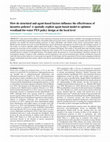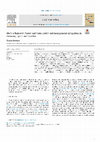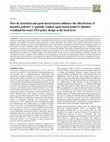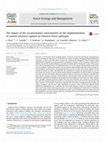Papers by Eulàlia Baulenas Serra

Ecology and Society, 2021
A key factor in the resilience of water and forest ecosystems in the face of climate variability ... more A key factor in the resilience of water and forest ecosystems in the face of climate variability is the management decisions taken by the individuals responsible for them, from public officials to private owners. The presence of economic and other non-material incentives can modify the decision-making processes of these individuals and thereby avoid current socioeconomic trends in Mediterranean forested areas such as land abandonment and its detrimental consequences for both social and ecological systems. In this article, we created a spatially explicit agent-based model to observe the effects of the implementation of a woodland-for-water payment for ecosystem services scheme in a local area in Catalonia (NE Spain). The results of the model show that the policy design that supports recurrent management practices obtains the same results at the 25-year mark that other policy designs at the end of the modeled period in number of managed hectares. This design entails the presence of a local intermediary, financial coverage of the management changes to improve water conditions, and the targeting of only one environmental goal, thereby avoiding the ecosystem trade-offs that can arise when two or more goals are targeted. In this design, the first generation of forest owners engaging in behavior change would benefit from their actions, which is also key for maintaining their engagement with the payments for ecosystem services scheme.

Land Use Policy, 2021
Abstract This article provides an analysis of cross-sectoral policy integration between two natur... more Abstract This article provides an analysis of cross-sectoral policy integration between two natural resource sectors: forest and water. Policy integration is defined as a vertical and horizontal process and we explore if perceptions of the effects of forest on water affect integration processes. We conducted a survey with forest and water stakeholders in three EU Member States – Germany, Spain and Sweden – with the aim to answer the following research questions: “How are forest and water perceptions distributed across sectors and stakeholders?” and “How do forest and water perceptions affect the process of cross-sectoral policy integration?”. Results show that with regard to the effects of forests on rainfall, there is more disagreement among stakeholders; however, in general, there is a rather positive view of the effects of forest on water. Positive perceptions are found related to increased chances of cross-sectoral collaboration and participation in joint research projects. This article concludes that the participants in our study are not naive about forest-water interactions and are open and already engaged in cross-scale, cross-sector and multi-stakeholder interactions. This is despite the perception in the literature that administrations are not engaging in the integration of the forest and water sectors, which might be due to the conceptualization of policy integration only as an output while dismissing the relevance of it as a process.

Forest Ecology and Management, 2016
Abstract Whenever a new invasive forest pathogen appears, resources are put into developing count... more Abstract Whenever a new invasive forest pathogen appears, resources are put into developing countermeasures such as breeding for resistance in the affected host species and/or by developing fungicide/biocontrol treatments. In most cases, little effort is placed into analysing the likelihood of those measures being implemented. Studying the reasoning behind management reactions of forest managers whose forests had been attacked by invasive pathogens can improve implementation of measures in case of future invasions. We used grounded theory to model forest owners’ reactions against chestnut blight caused by the invasive pathogen Cryphonectria parasitica . We focussed on understanding what drove some managers to keep managing chestnut forests and applying biological control, and what made others abandon or even substitute chestnut by exotics. We found that the availability of a market for chestnut products, and not the disease was the main reason for discontinuing chestnut management. The will to continue managing chestnuts was four times higher amongst managers of chestnut stands for nut production (valuable crop), than amongst managers of coppice stands producing small diameter stems, currently without a market. Requesting application of biological control against chestnut blight was four times more likely amongst forest managers obtaining monetary benefits from their land (benefits used as profit or re-investment) than those not obtaining monetary benefits or currently losing money with their land. Substitution with exotic conifers was associated with forest managers that had learned management from family and leaders of opinion, and that have either themselves or previous owners of the land planted exotics beforehand. Abandonment was associated with self-taught managers valuing non-monetary aspects of forests and having moral reasons against exotics. Our research highlights the importance of considering the socioeconomic context around the affected tree species when developing measures against invasive forest pathogens, and raises concerns about the continuity of tree species affected by invasive pathogens with little or no commercial value.

Research article, 2021
This article provides an analysis of cross-sectoral policy integration between two natural resour... more This article provides an analysis of cross-sectoral policy integration between two natural resource sectors: forest and water. Policy integration is defined as a vertical and horizontal process and we explore if perceptions of the effects of forest on water affect integration processes. We conducted a survey with forest and water stakeholders in three EU Member States – Germany, Spain and Sweden – with the aim to answer the following research questions: “How are forest and water perceptions distributed across sectors and stakeholders?” and “How do forest and water perceptions affect the process of cross-sectoral policy integration?”. Results show that with regard to the effects of forests on rainfall, there is more disagreement among stakeholders; however, in general, there is a rather positive view of the effects of forest on water. Positive perceptions are found related to increased chances of cross-sectoral collaboration and participation in joint research projects. This article concludes that the participants in our study are not naïve about forest-water interactions and are open and already engaged in cross-scale, cross-sector and multi-stakeholder interactions. This is despite the perception in the literature that administrations are not engaging in the integration of the forest and water sectors, which might be due to the conceptualization of policy integration only as an output while dismissing the relevance of it as a process.

Research article, 2021
A key factor in the resilience of water and forest ecosystems in the face of climate variability ... more A key factor in the resilience of water and forest ecosystems in the face of climate variability is the management decisions taken by the individuals responsible for them, from public officials to private owners. The presence of economic and other non-material incentives can modify the decision-making processes of these individuals and thereby avoid current socioeconomic trends in Mediterranean forested areas such as land abandonment and its detrimental consequences for both social and ecological systems. In this article, we created a spatially explicit agent-based model to observe the effects of the implementation of a woodland-for-water payment for ecosystem services scheme in a local area in Catalonia (NE Spain). The results of the model show that the policy design that supports recurrent management practices obtains the same results at the 25-year mark that other policy designs at the end of the modeled period in number of managed hectares. This design entails the presence of a local intermediary, financial coverage of the management changes to improve water conditions, and the targeting of only one environmental goal, thereby avoiding the ecosystem trade-offs that can arise when two or more goals are targeted. In this design, the first generation of forest owners engaging in behavior change would benefit from their actions, which is also key for maintaining their engagement with the payments for ecosystem services scheme.
Research article, 2021
Natural resource management requires cross-sectoral policy integration because the scope of curre... more Natural resource management requires cross-sectoral policy integration because the scope of current environmental and sustainability issues surpasses traditional sectoral boundaries. While the emergence of policy networks in such cases has been observed in the policy integration literature, little is known about how these net

Whenever a new invasive forest pathogen appears, resources are put into developing countermeasure... more Whenever a new invasive forest pathogen appears, resources are put into developing countermeasures such as breeding for resistance in the affected host species and/or by developing fungicide/biocontrol treatments. In most cases, little effort is placed into analysing the likelihood of those measures being implemented. Studying the reasoning behind management reactions of forest managers whose forests had been attacked by invasive pathogens can improve implementation of measures in case of future invasions. We used grounded theory to model forest owners' reactions against chestnut blight caused by the invasive pathogen Cryphonectria parasitica. We focussed on understanding what drove some managers to keep managing chestnut forests and applying biological control, and what made others abandon or even substitute chestnut by exotics. We found that the availability of a market for chestnut products, and not the disease was the main reason for discontinuing chestnut management. The will to continue managing chestnuts was four times higher amongst managers of chestnut stands for nut production (valuable crop), than amongst managers of coppice stands producing small diameter stems, currently without a market. Requesting application of biological control against chestnut blight was four times more likely amongst forest managers obtaining monetary benefits from their land (benefits used as profit or re-investment) than those not obtaining monetary benefits or currently losing money with their land. Substitution with exotic conifers was associated with forest managers that had learned management from family and leaders of opinion, and that have either themselves or previous owners of the land planted exotics beforehand. Abandonment was associated with self-taught managers valuing non-monetary aspects of forests and having moral reasons against exotics. Our research highlights the importance of considering the socioeconomic context around the affected tree species when developing measures against invasive forest pathogens, and raises concerns about the continuity of tree species affected by invasive pathogens with little or no commercial value.










Uploads
Papers by Eulàlia Baulenas Serra